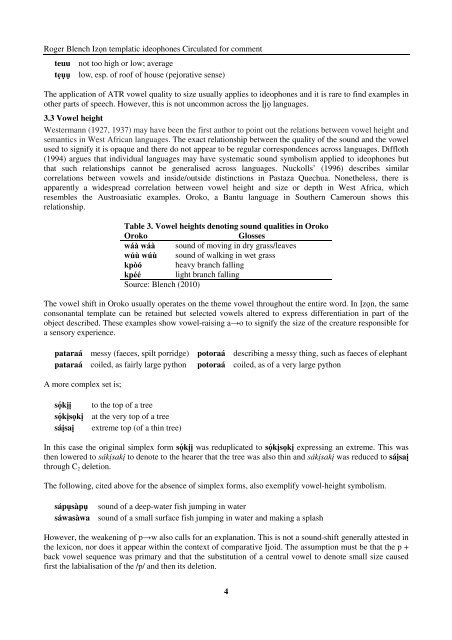Kolokuma ideophones.pdf - Roger Blench
Kolokuma ideophones.pdf - Roger Blench
Kolokuma ideophones.pdf - Roger Blench
Create successful ePaper yourself
Turn your PDF publications into a flip-book with our unique Google optimized e-Paper software.
<strong>Roger</strong> <strong>Blench</strong> Izọn templatic <strong>ideophones</strong> Circulated for comment<br />
teuu not too high or low; average<br />
tẹụụ low, esp. of roof of house (pejorative sense)<br />
The application of ATR vowel quality to size usually applies to <strong>ideophones</strong> and it is rare to find examples in<br />
other parts of speech. However, this is not uncommon across the Njọ languages.<br />
3.3 Vowel height<br />
Westermann (1927, 1937) may have been the first author to point out the relations between vowel height and<br />
semantics in West African languages. The exact relationship between the quality of the sound and the vowel<br />
used to signify it is opaque and there do not appear to be regular correspondences across languages. Diffloth<br />
(1994) argues that individual languages may have systematic sound symbolism applied to <strong>ideophones</strong> but<br />
that such relationships cannot be generalised across languages. Nuckolls’ (1996) describes similar<br />
correlations between vowels and inside/outside distinctions in Pastaza Quechua. Nonetheless, there is<br />
apparently a widespread correlation between vowel height and size or depth in West Africa, which<br />
resembles the Austroasiatic examples. Oroko, a Bantu language in Southern Cameroun shows this<br />
relationship.<br />
Table 3. Vowel heights denoting sound qualities in Oroko<br />
Oroko<br />
Glosses<br />
wáà wáà sound of moving in dry grass/leaves<br />
wúù wúù sound of walking in wet grass<br />
kpòó heavy branch falling<br />
kpéé light branch falling<br />
Source: <strong>Blench</strong> (2010)<br />
The vowel shift in Oroko usually operates on the theme vowel throughout the entire word. In Nzọn, the same<br />
consonantal template can be retained but selected vowels altered to express differentiation in part of the<br />
object described. These examples show vowel-raising a→o to signify the size of the creature responsible for<br />
a sensory experience.<br />
pataraá messy (faeces, spilt porridge) potoraá describing a messy thing, such as faeces of elephant<br />
pataraá coiled, as fairly large python potoraá coiled, as of a very large python<br />
A more complex set is;<br />
sọ́ kịị to the top of a tree<br />
sọ́ kịsọkị at the very top of a tree<br />
sáịsaị extreme top (of a thin tree)<br />
In this case the original simplex form sọ́ kịị was reduplicated to sọ́ kịsọkị expressing an extreme. This was<br />
then lowered to sákịsakị to denote to the hearer that the tree was also thin and sákịsakị was reduced to sáịsaị<br />
through C 2 deletion.<br />
The following, cited above for the absence of simplex forms, also exemplify vowel-height symbolism.<br />
sápụsàpụ sound of a deep-water fish jumping in water<br />
sáwasàwa sound of a small surface fish jumping in water and making a splash<br />
However, the weakening of p→w also calls for an explanation. This is not a sound-shift generally attested in<br />
the lexicon, nor does it appear within the context of comparative Ijoid. The assumption must be that the p +<br />
back vowel sequence was primary and that the substitution of a central vowel to denote small size caused<br />
first the labialisation of the /p/ and then its deletion.<br />
4

















